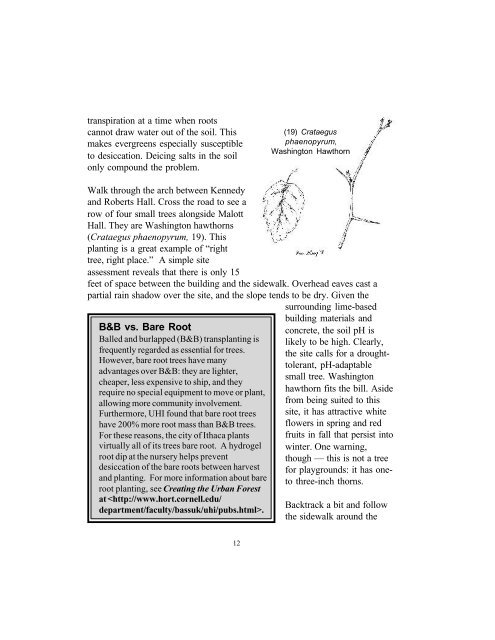Recommended Urban Trees: A Cornell Campus Walk - Horticulture ...
Recommended Urban Trees: A Cornell Campus Walk - Horticulture ...
Recommended Urban Trees: A Cornell Campus Walk - Horticulture ...
You also want an ePaper? Increase the reach of your titles
YUMPU automatically turns print PDFs into web optimized ePapers that Google loves.
transpiration at a time when roots<br />
cannot draw water out of the soil. This<br />
makes evergreens especially susceptible<br />
to desiccation. Deicing salts in the soil<br />
only compound the problem.<br />
<strong>Walk</strong> through the arch between Kennedy<br />
and Roberts Hall. Cross the road to see a<br />
row of four small trees alongside Malott<br />
Hall. They are Washington hawthorns<br />
(Crataegus phaenopyrum, 19). This<br />
planting is a great example of “right<br />
tree, right place.” A simple site<br />
assessment reveals that there is only 15<br />
feet of space between the building and the sidewalk. Overhead eaves cast a<br />
partial rain shadow over the site, and the slope tends to be dry. Given the<br />
surrounding lime-based<br />
B&B vs. Bare Root<br />
Balled and burlapped (B&B) transplanting is<br />
frequently regarded as essential for trees.<br />
However, bare root trees have many<br />
advantages over B&B: they are lighter,<br />
cheaper, less expensive to ship, and they<br />
require no special equipment to move or plant,<br />
allowing more community involvement.<br />
Furthermore, UHI found that bare root trees<br />
have 200% more root mass than B&B trees.<br />
For these reasons, the city of Ithaca plants<br />
virtually all of its trees bare root. A hydrogel<br />
root dip at the nursery helps prevent<br />
desiccation of the bare roots between harvest<br />
and planting. For more information about bare<br />
root planting, see Creating the <strong>Urban</strong> Forest<br />
at .<br />
12<br />
(19) Crataegus<br />
phaenopyrum,<br />
Washington Hawthorn<br />
building materials and<br />
concrete, the soil pH is<br />
likely to be high. Clearly,<br />
the site calls for a droughttolerant,<br />
pH-adaptable<br />
small tree. Washington<br />
hawthorn fits the bill. Aside<br />
from being suited to this<br />
site, it has attractive white<br />
flowers in spring and red<br />
fruits in fall that persist into<br />
winter. One warning,<br />
though — this is not a tree<br />
for playgrounds: it has oneto<br />
three-inch thorns.<br />
Backtrack a bit and follow<br />
the sidewalk around the

















